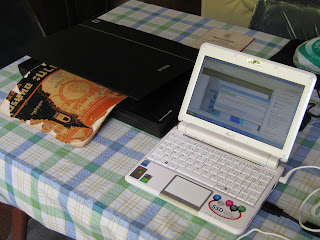[Last updated 6 January 2019 (determined a few more of the labels on the cover)]
As mentioned previously, in my recent trip to Thailand I had been shown a number of printed items that were published by Wat Paknam in the 1950s. I was able to borrow any that I was interested in and quickly decided to buy a scanner. With the help of a friend, Khun Yuttana, who works in I.T. in Bangkok, I bought an Epson Perfection V33 scanner, which is based on CCD technology and makes a good attempt at capturing bulky objects. It also came bundled with a ‘lite’ version of Abbyy Finereader 9 that included Thai OCR, but it’s not really practical for older documents with faded print.
I partnered the scanner with my ubiquitous netbook as below:

The combination worked fine, but being pressed for time I cut some corners that probably reduced the quality of the results - I should have placed the scanner flush with the edge of the table and held the overhanging pages at 90 degrees. (It’s even trickier when there are mosquitoes milling about!)
You might wonder what is the item under the lid. At first glance I had expected a book or manual, but it turned out to be an annual produced by monks at Wat Paknam.

The English reads:
THE MAGAZINE
OF THE JUNIOR BHIKKHUS OF
WAT PAK NAM, PHASICHAREON
DHONBURI, THAILAND
For the year B.E. 2497. C.E. 1954
That's the easy bit and I also recognise the temple crest with its name underneath - วัดปากน้ำภาษีเจริญ ธนบุรี, i.e. Wat Paknam Bhasicharoen, Thonburi. So far so good. However I usually struggle with transcribing Thai, especially if the fonts are stylised, as is the case for the larger lettering. Fortunately, having made out one of the words in the main diagram, I could determine the others.
So starting top left, underneath the name of the temple is โอปนยิโก. This, I’m quite sure, is the Thai phonetic spelling of a Pali term that is usually rendered in Roman script as opanayiko. It’s an important term that is included in daily recitation about the Dhamma, the second aspect of the Triple Gem (Svakhato bhagavata dhammo...), and is perhaps what we’re encouraged to recall. According to Pali-English dictionaries it is an adjective translated as “leading to” that, as here, is usually associated with the goal of nibbana. There is, though, perhaps a more specific sense that comes via another translation “leading onwards.” Given that the path is through meditation and it is “within this fathom long body” that we find deliverance, it then makes more sense to say “leading inwards” and this emphasizes the general process of internalising Dhamma. I think confidence in its proper translation depends on meditation experience.
It soon becomes evident that the sprinkling of other words are also taken from the Dhamma portion of the iti pi so. Thus, directly underneath the image of the Buddha in meditation is ปจฺจตฺตํ, which is alternatively written, ปัจจัตตัง, the phonetic rendering of the Pali paccattaṃ, which means 'individually, by oneself'. And to the right is เอหิปัสสิโก, i.e. the Pali ehipassiko, which means "Come and see!". As to the large letters at the foot of the page, I am stumped! So I shall have to ask some Thai friends for assistance.
The magazine is approximately US letter size and over 360 pages long – I guess this was a bumper edition given the arrival of the first Western ordinand, one who was particularly active that year. There’s a wide range of articles with plenty of photographs, reflecting the diverse activities, based mainly around scholarship and meditation. What is probably distinctive for that period is the fact that it contains substantial articles in English as well as Thai; and many of the photographs have labels in English, adding to the sense that this aimed to be an international publication.
The English language content includes the following:
- A biography of Chao Khun Bhavanakosol Maha Thera by Kapilavaddho Bhikkhu (W. August Purfurst) [10 pages]
- Article: ‘The Essence of the Dhamma’ by Kapilavaddho Bhikkhu (W. August Purfurst) – transcript of a lecture given at the Thai - Chine Pracha Association, on Saturday 2, October 1954 [14 pages] (This was likely organised with the assistance of Ajahn Gaew).
- A Photographic record of Wat Paknam Bhasichareon, Dhonburi, Thailand [16 pages]
- Article: ‘An Introduction to Buddhist Philosophy’ - a transcript of a 2 day interview between Ven. Kapilavaddho and Robert Samek, Senior Lecturer in Commercial Law, Melbourne University and Ven. Kapilavaddho, 2-3 August 1954. This was “electronically recorded” – probably using audio tape recorder. Also included is a diagram of Dependent Origination, produced in 1950. [64 pages]
Unfortunately, the results of my scans were rather mixed in quality. I’m sorry to say there are many pages where words at the margins have disappeared or are unreadable. Even so, with a bit of extra effort I think this may still be largely achievable or otherwise another attempt could be made at scanning.
1 comment:
Post a Comment